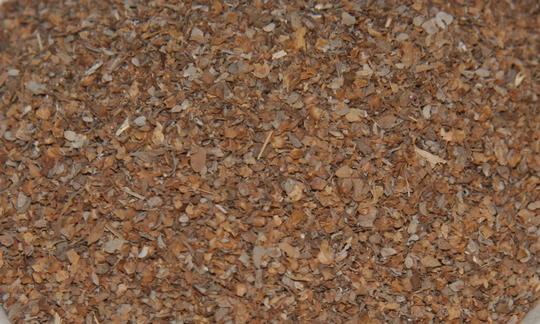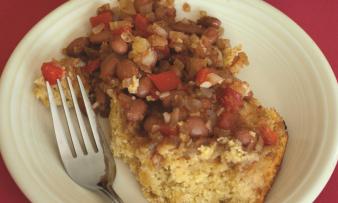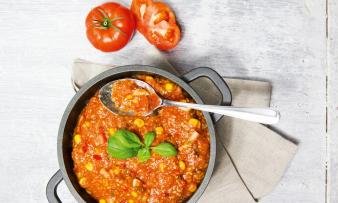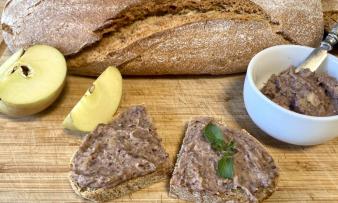Table of contents
Dried marjoram ( Origanum majorana) is used to season mainly hearty and Mediterranean dishes. After conventional drying, it is usually no longer raw, but it is available in organic quality.
Use in the kitchen
The herb marjoram ( Origanum majorana), also known as sausage herb, smells aromatic and tastes spicy. Its relative, oregano ( Origanum vulgare), has a slightly more intense and bitter taste than marjoram. 1
Marjoram can be used both fresh and dried. This article focuses on the use of the dried herb. You can find out more about the use of fresh marjoram (raw) in the corresponding article.
In which dishes is dried marjoram used? Dried marjoram is a popular seasoning that is used in particular in Mediterranean dishes (e.g. tomato sauces, pasta dishes, soups), potato dishes (e.g. potato soup, potato salad, fried potatoes), vegetable dishes such as casseroles, mushroom dishes and sauces. Dried marjoram is also often used to season sausages (including vegan ones). You can find a delicious recipe for a vegan and low-calorie "liver sausage" spread here. Marjoram goes well with dishes with pulses such as lentils and beans and makes them more digestible. 2 It is also ideal as an ingredient in salad dressings, spreads and dips for raw foods.
Spice mixtures of dried marjoram with other dried herbs such as oregano, thyme, rosemary and basil (e.g. " Herbs of Provence " mixtures) taste particularly good with vegetable dishes.
Is dried marjoram raw? Depending on the drying method, dried marjoram can still be raw. If the temperature stays below 42 °C, the product is of raw food quality. Conventional, industrial drying of herbs usually takes place at higher temperatures. On the other hand, you can easily follow raw food standards if you dry herbs yourself.
You can replace dried marjoram with fresh marjoram. However, since dried herbs have a more intense flavor, you should adjust the amount of fresh herbs accordingly. The rule of thumb for most herbs is: 1 teaspoon of the dried herb is equal to 1 tablespoon of the fresh herb.
Drying marjoram yourself
If you grow marjoram in your garden or on your balcony, you can dry it yourself - either in the air or in the oven or dehydrator.
In the air: The most gentle way to dry marjoram is in the air. To do this, tie freshly harvested shoots together with a household string or raffia thread to form small, loose bunches. These are hung upside down in an airy, dry place with temperatures below 30 °C and out of direct sunlight. The drying process is complete when the plant parts rustle when touched and the leaves have a crumbly consistency. This should be the case after about three to four days. Now you can strip the leaves from the stems and put them in airtight containers such as screw-top jars for storage. 3
In the oven or dehydrator: Preheat the oven to about 40 °C, place the plant parts on a baking tray lined with baking paper and put it in the oven. The process takes about three to four hours. During this time, the oven door should be left ajar so that moisture can escape. Set the dehydrator to 40 °C and let the herbs dry for three to four hours. 3
Vegan recipe for goulash with dried marjoram
Ingredients (4 people): 600 g potatoes, 250 g smoked tofu, 1 onion, 4 cloves of garlic, 1 teaspoon rapeseed oil, 5 tablespoons paprika powder (sweet), 1 tablespoon tomato paste, 1 teaspoon marjoram (dried, organic), a little salt andpepper.
Preparation: Rinse the potatoes and cut into cubes. Cut the smoked tofu into cubes as well. Peel and finely chop the onions and garlic cloves. Heat the rapeseed oil in a large pot and fry the onions and garlic briefly. Add the potatoes, smoked tofu and paprika powder, stir and fry for about 3 minutes. Add enough water to cover the potatoes. Simmer the vegan goulash uncovered on a medium heat for about 45 minutes until the potatoes are soft. Stir occasionally. Stir in the tomato paste and dried marjoram and season with salt and pepper. If you like, you can season the vegan goulash with a little hot paprika powder.
Vegan recipes with marjoram (dried) can be found under the note: " Recipes that have the most of this ingredient ".
| Not only vegans or vegetarians should read this: Vegans often eat unhealthily. Avoidable nutritional errors. |
Purchasing - Storage
Dried marjoram is available all year round in most supermarkets (e.g. Coop, Migros, Denner, Volg, Spar, Aldi, Lidl, Rewe, Edeka, Hofer, Billa). You can find it shredded in spice jars or small bags. Organic supermarkets (e.g. Denn's Biomarkt, Alnatura) also offer dried marjoram in organic quality.
The availability of marjoram (dried) varies depending on the size of the store, catchment area, etc. Our recorded food prices for the DA-CH countries can be found above under the ingredient image - and by clicking on them you can see their development at various suppliers.
Storage tips
Dried marjoram can be stored for several years if protected from light, dry and hermetically sealed.
Ingredients - Nutritional values - Calories
Here we realistically show you the ingredients of spices and herbs per 1 g (instead of per 100 g as usual).
1 g of dried marjoram has a calorie content of 2.71 kcal. The carbohydrate content is 0.61 g/1g. The dried plant contains 0.4 g/1g of fiber, 0.13 g/1g of protein and hardly any fat. 4
Dried marjoram contains a lot of vitamin K at 6.2 µg/1g, the same amount is found in dried oregano. An even higher content can be found in other dried herbs such as wild garlic (26.3 µg/1g), basil (17.1 µg/1g) and thyme (17.1 µg/1g). 4
The iron content in 1 g of dried marjoram is 0.8 mg/1g. This is similar to that of dried basil (0.9 mg/1g). Dried thyme contains even more iron (1.2 mg/1g). 4
0.05 mg of manganese are contained in 1 g of the dried herb. Dried oregano (0.05 mg/1g) and dried coriander leaves (0.6 mg/1g) have a similar content. Dried parsley and dried basil contain even more manganese at 0.1 mg/1g. 4
The complete ingredients of marjoram (dried), the coverage of the daily requirement and comparison values with other ingredients can be found in our nutrient tables. In the article Nutrients explained you will get a detailed insight into the topic.
Health effects
Marjoram ( Origanum majorana) is a medicinal plant with various proven pharmacological properties, which are due to the essential oil it contains (with terpinenes and terpinolene), phenolic compounds, tannins, bitter substances and carotenes. The extracts and essential oils from marjoram exhibit, among other things, antibacterial properties against various pathogenic bacteria such as Bacillus subtilis, Enterococcus faecalis, Escherichia coli, Klebsiella pneumonia, Salmonella choleraensius and Serratia sp. In addition, studies have shown that marjoram has antifungal effects against pathogenic fungi such as Aspergillus niger, Trichoderma viride, Phytophthora spp., Candida sp. and Penicillium cyclopium. The antidiabetic property is due to phenolic compounds in Origanum majorana. Marjoram protects the liver and heart, strengthens the stomach and is antispasmodic and carminative (flatulent). Its anti-atherosclerotic effect protects against arteriosclerosis, while its anticoagulant properties protect against diseases caused by blood clots such as heart attacks, strokes, venous thrombosis and embolisms. Studies also report on the anti-inflammatory, pain-relieving and antipyretic effects of marjoram. In addition, marjoram has antioxidant activity and has antimutagenic and anticancer effects. 5,6
Dangers - Intolerances - Side effects
Toxicological assessments confirm the safety of marjoram ( Origanum majorana). 5,6 However, pregnant and breastfeeding women are advised not to use marjoram essential oils as they can have an emmenagogue effect (stimulating blood flow in the uterus). 5,7
An overdose and prolonged use (over several weeks) of the essential oil can lead to headaches and dizziness. 2
Folk medicine - natural medicine
Marjoram is an important herb in folk medicine. Dried leaves, leaf extracts and essential oils of marjoram are used there. They are used in various countries to treat a variety of ailments. Does marjoram have an effect on blood pressure? In Morocco, the plant is considered to lower blood pressure, in Iran, marjoram is used for heart pain and cardiac arrhythmia, among other things, in Austria, diseases of the gastrointestinal tract and infections are treated with marjoram, and in England, the dried leaves are used to treat colds, bronchial cough and asthmatic whooping cough. 5 In addition, the herb is used for allergies, diabetes, stomach pain, intestinal cramps and painful menstruation, but also for tension headaches, insomnia and anxiety. 1,6
Pharmacist Mannfried Pahlow recommends applying marjoram ointment to the navel area of babies who are suffering from stomach pressure or flatulence. It can also be used to treat colds in babies and small children. 2 The external application of marjoram also provides relief from muscle pain, nerve pain, sprains and strains and helps with poorly healing wounds, ulcers, arthritis and rheumatism. 1,2
Ecological footprint - animal welfare
If you were to consume a third of your daily nutrient requirement through marjoram, which would be 889 g, you would get (roughly) a CO 2 footprint of 283 g CO₂eq. That is a very good value. In general, you can eat unprocessed plant products without feeling guilty. 11
Studies on the ecological impact of the production and marketing of herbs are rare. However, we were able to find one study in which researchers calculated the carbon footprint and water footprint of oregano ( Origanum vulgare), a close relative of marjoram (oregano subspecies). According to this calculation, organic oregano had a global warming potential of 0.069 kg CO 2 /kg - a very small footprint. The water footprint was also very small, which is of course no surprise for Mediterranean herbs adapted to drought. 13
Depending on the drying method and transport, additional environmental impacts can occur and increase the ecological balance many times over. 15
The 'footprint' of a food product depends on various factors. The type of agricultural production (conventional vs. organic), average vs. seasonal vs. regional production, domestic production vs. import by truck, ship or plane, different types of packaging and whether the product is fresh or frozen all play a decisive role.
If you only use small amounts of herbs occasionally, it is best to use dried herbs - these have a long shelf life and therefore lead to less waste. It is more environmentally friendly to buy large refill packs instead of buying a new spice jar or tin every time. 8 Also look for organic products that have not been transported too far.
Detailed explanations of various sustainability indicators (such as ecological footprint, CO2 footprint, water footprint) can be found here.
Animal welfare - species protection
The oregano species , which also includes marjoram, provides food and living space for a variety of insects. Beneficial insects and natural enemies of pests, the "little garden helpers", are also attracted to the plant. 12,14
Worldwide occurrence - cultivation
Marjoram originated in Cyprus and Turkey and is now native to the Mediterranean region. 9 It is cultivated in Asia, North Africa and Europe, e.g. in Spain, Hungary, Portugal, Germany, Poland and France, as a spice and supplier of essential oil. 5,7
Industrial production
Since marjoram is a perishable herb, drying the herb is a useful option to extend its shelf life. Drying is probably the oldest and most commonly used method of preserving herbs. The most common drying method today is convective drying, in which the moisture content of the material is greatly reduced by hot air. There are also methods that combine convective drying with microwave drying (irradiation with high-energy electromagnetic waves). Another method is microwave drying under vacuum. 10
Aromatic substances are among the most heat-sensitive components of marjoram. These are influenced by drying. A 2015 study examined the effects of various drying methods (convective drying, vacuum-microwave drying and a combination of convective pre-drying and vacuum-microwave final drying) on the taste quality of dried marjoram. Vacuum-microwave drying proved to be the best drying method in terms of preserving aromatic substances. 10
Further information
Marjoram ( Origanum majorana) belongs to the genus Origanum in the mint family (Lamiaceae). Oregano, also known as wild marjoram, belongs to the same genus.
Alternative names
In addition to Wurstkaut, marjoram has the following common names: Bratenkrätel, Gartenmarjoran, Kuchelkraut, Mairan, Mairon, Miran. 2 In addition, there are names such as Badkraut, Bratekräutche, Kuttelkraut, Meiran, Mussärol and Mairalkraut.
In English, dried marjoram is called dried marjoram or dried sweet marjoram.
Other uses
Marjoram plants are used in perfumery because of their essential oil and in the pharmaceutical and food industries because of their insecticidal and fungicidal effects. 10
Bibliography - 15 Sources
| 1. | Bown D. The Royal Horticultural Society. Encyclopedia of Herbs & their Uses. Dorling Kindersley: London; 1995: 319-20. |
| 2. | Pahlow M. Das grosse Buch der Heilpflanzen. Gesund durch die Heilkräfte der Natur. Nikol Verlagsges. mbH: Litauen; 2013: 39, 42-3, 220-3. |
| 3. | Mein-schoener-garten de: Majoran ernten und trocknen: So geht’s. |
| 4. | USDA United States Department of Agriculture. |
| 5. | Bina F, Rahimi R. Sweet Marjoram. J Evid Based Complementary Altern Med. 2017;22(1):175–85. |
| 6. | Bouyahya A, Chamkhi I, Benali T, Guaouguaou FE, Balahbib A, El Omari N, u. a. Traditional use, phytochemistry, toxicology, and pharmacology of Origanum majorana L. J Ethnopharmacol. 2021;265:113318. |
| 7. | Chevallier A. Das grosse Lexikon der Heilpflanzen. Dorling Kindersley Verlag GmbH: München; 2017: 242. |
| 8. | Swrfernsehen de: Kräuter im Nachhaltigkeits-Check. Basilikum, Petersilie & Co. – frische Kräuter im Topf, als Bund, tiefgekühlt oder getrocknet? |
| 9. | Powo science kew org: Origanum majorana L. |
| 10. | Calín-Sánchez A. Figiel A. Lech K. Szumny A. Martínez-Tomé J. Carbonell-Barrachina AA. Dying methods affect the aroma of Origanum majorana L. analyzed by GC–MS and descriptive sensory analysis. Industrial Crops and Products. 2015;74:218–27. |
| 11. | Greenpeace Schweiz, Stadt Zürich, Planted Foods AG, Branding Cuisine, Tinkerbelle, Inge, myblueplanet, ProVeg International, Dr. Earth, FightBack und Eaternity. All You Can Eatfor climate - Poster. ayce.earth. 2022. |
| 12. | Walliser J. Attracting beneficial bugs to your garden, revised and updated second edition: a natural approach to pest control. Cool Springs Press; 2022. 210 S. |
| 13. | Litskas V, Chrysargyris A, Stavrinides M, Tzortzakis N. Water-energy-food nexus: A case study on medicinal and aromatic plants. Journal of Cleaner Production. Oktober 2019;233:1334–43. |
| 14. | Stathakis T, Economou L, Barda M, Angelioudakis T, Kati V, Karamaouna F. Potential of Hedgerows with Aromatic Plants as Reservoirs of Natural Enemies of Pests in Orange Orchards. Insects. 17. April 2023;14(4):391. |
| 15. | Carboncloud. Schweden. Herbs, dried, orig: TUN. 2024. |











Comments